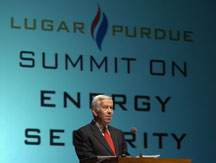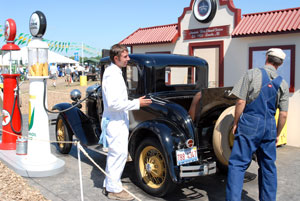 The media has made much this week about the Consumer Reports report that ethanol is less fuel efficient than gasoline. This is something the ethanol industry freely admits.
The media has made much this week about the Consumer Reports report that ethanol is less fuel efficient than gasoline. This is something the ethanol industry freely admits.
The “quick take” from the Consumer Report is this:
E85, which is 85 percent ethanol, emits less smog-causing pollutants than gasoline, but provides fewer miles per gallon, costs more, and is hard to find outside the Midwest.
All true statements at this particular point in time. The first statement – that ethanol “emits less smog-causing pollutants than gasoline” – is universally true and will not change. It is also one of the primary reasons that people who are concerned about global warming or other environmental issues should advocate the use of ethanol in this country.
The second statement – that ethanol provides few miles per gallon – could change if auto makers come up with different types of engines that are made to run on ethanol instead of gasoline. Indy cars are being tuned to run more efficiently on ethanol, since they are making the switch to 100 percent ethanol next year.
Third – ethanol costs more. This is a changable truth. Consumer Reports only looked at ethanol prices in the past several months when they have been historically high due to strong demand fueled by the switch from MTBE to ethanol as an oxygenate in major metropolitan areas. The basic law of supply and demand dictates that the price will decline as the supply increases, and in fact, prices have already come down in recent weeks.
Finally, the lack of availability outside the midwest is changing every day. For example, Phil Lampert with the National Ethanol Vehicle Coalition notes that Kroger just opened about 20 new E85 fueling stations in Texas, and he says, “By this time next year we expect to have 300 (e85) stations in New York state where today there are zero.”
NEVC would like to see 1500 E85 pumps around the nation by the end of this year. The NEVC website www.e85fuel.org is updated daily with new places where E85 fuel can be found around the nation.
Since most ethanol production facilities are located in the midwest, that’s where most of the E85 pumps are going right now. But, as production begins to start up in New York, California, Texas, Florida, etc. there will be more and more. Ethanol is about the environment, national security and vehicle performance, not about fuel economy. But, hopefully as production increases it will ultimately end up costing less and saving consumers money in the long run.
No one expects ethanol to completely replace gasoline, but simply REDUCING our dependence on foreign oil is a step in the right direction.
 Here’s another from the “Better Late Than Never” file. Okay, so it’s only a couple of weeks old… sent August 18.
Here’s another from the “Better Late Than Never” file. Okay, so it’s only a couple of weeks old… sent August 18.

 It’s a holiday so I am cleaning out my email and catching up on some posts that should have been done already.
It’s a holiday so I am cleaning out my email and catching up on some posts that should have been done already.  Indiana Republican Senator Dick Lugar copped
Indiana Republican Senator Dick Lugar copped  Here is a really
Here is a really 
 The media has made much this week about the
The media has made much this week about the  The latest “Fill Up, Feel Good” podcast from the
The latest “Fill Up, Feel Good” podcast from the 
 A new exhibit out here at the Farm Progress Show was put together in just the last 45 days by FlexFuel Motors.
A new exhibit out here at the Farm Progress Show was put together in just the last 45 days by FlexFuel Motors. It seems like the number 17 Team Ethanol Indy Car is all over the place. It’s here on display at the Farm Progress Show courtesy of the Ethanol Promotion and Information Council (EPIC).
It seems like the number 17 Team Ethanol Indy Car is all over the place. It’s here on display at the Farm Progress Show courtesy of the Ethanol Promotion and Information Council (EPIC). I asked Alan how it’s going here at the show. He says the line has been long at times with people waiting their turn driving the car. As a farmer he’s very proud of the work being done in the renewable fuels area to make America independent of foreign oil. He doesn’t mind the hard work and long hours driving this demonstrator around the country to promote ethanol which he firmly believes is good for America, the environment and farmers like himself. He not only grows corn that’s turned into ethanol but feeds the by-product (DDG’s) to his cattle.
I asked Alan how it’s going here at the show. He says the line has been long at times with people waiting their turn driving the car. As a farmer he’s very proud of the work being done in the renewable fuels area to make America independent of foreign oil. He doesn’t mind the hard work and long hours driving this demonstrator around the country to promote ethanol which he firmly believes is good for America, the environment and farmers like himself. He not only grows corn that’s turned into ethanol but feeds the by-product (DDG’s) to his cattle.